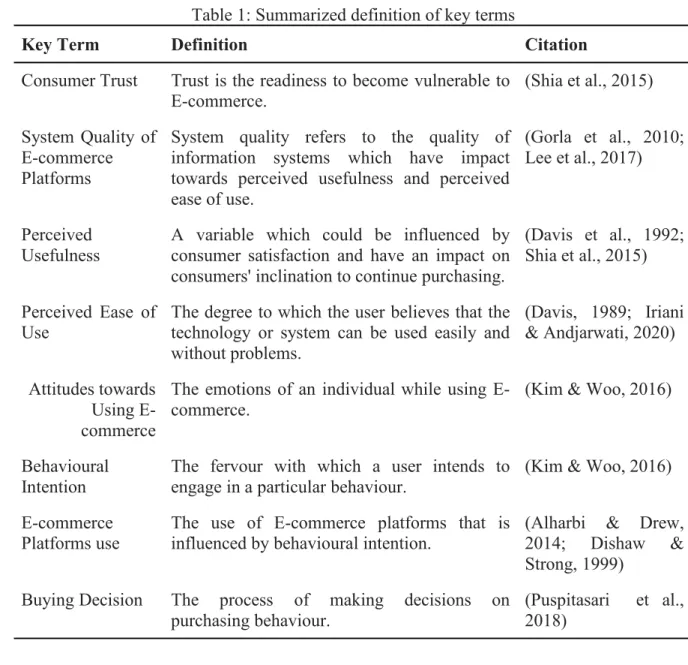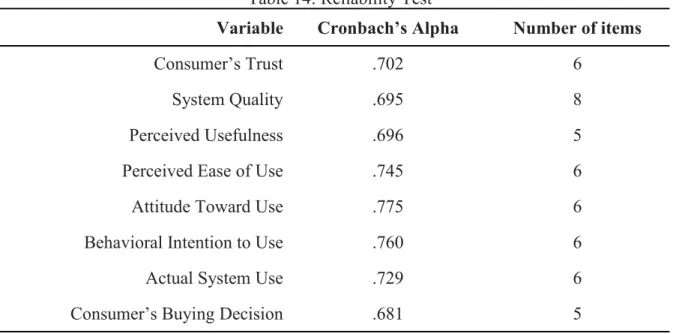This attached research paper titled "Influence of Consumers' Trust and E-commerce Platform System Quality on Buying Decision during Covid-19 Pandemic". An online survey was distributed to 330 respondents from different age groups to investigate the differences in perceived usefulness and perceived ease of use between age groups, as well as the influence of e-commerce platforms on consumer purchase decisions (under 24, 25-44 and 45 and over, etc.) The responses were analyzed using multiple linear regression and the ANOVA test, respectively.
1.1 Introduction
- Background
- Problem Statement
- Research Questions
- Research Objectives
- Research Significance .1 Theoretical Significance
- Practical Significance
- Scope of study
- Definitions of key terms
- Summary
Several countries, including Malaysia, bear the brunt of the scenario's consequences (Shah et al., 2020). Individuals' lifestyles and purchasing behavior are changing as the Covid-19 pandemic spreads worldwide (Alhaimer, 2021; Gu et al., 2021).
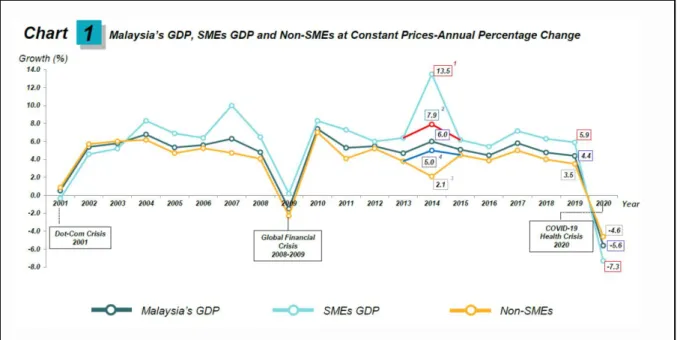
2.1 Introduction
E-commerce
This is one of the reasons why individuals are currently more likely to use e-commerce (Khan, 2016). In addition, individuals are more likely to use e-commerce as it can meet their needs, according to Davis (1989), who argued that people believe that their performance will improve when they can use the system.
Four Features of E-commerce A. Ubiquitous
The complexity and content of a message are referred to as richness (Shafiyah et al., 2013; UKEssays, 2018). According to Shafiyah et al. 2013), branding and advertising are critical in e-commerce to attract customers.
The roles of E-commerce during Covid-19
Also, according to The Star news, Malaysia is moving online beyond MCO and bridging the gap between online and offline retail. Retail businesses had to transmit online to survive (“Bridging Online and Offline Retail as Malaysia Moves Beyond MCO.
Comparison of perception of different age groups
According to Lazada Malaysia CEO Leo Chow, Shopee conducted a survey which found that out of the 11,850 sellers surveyed, 5,406 are e-commerce empowered new entrepreneurs who run their businesses entirely online and despite being fully employed, used 35.4 percent of the respondents e-commerce. as a second or third source of income (Nathan, 2020). Despite this, there are approx. 45,000 new micro SMEs added to various e-commerce platforms such as Lazada and Shopee in the year 2020, meaning more than 245 businesses benefit from e-commerce ("Bridging Online and Offline Retail as Malaysia Moves longer than MCO.
Perception of Generation X
This was demonstrated by the discussion of Sorce et al. 2005) that once elderly customers have searched for a product online, those less favored to search for a product online from them will be more likely to buy it online than younger customers. Although older population may take longer for the adoption process, they have the advantage of spending less time researching items due to their extensive shopping experience in an offline environment (Wan et al., 2012).
Perception of Generation Y
- Customer Decision Process
- Advantages of E-commerce toward the business
Compared to the older generations, the younger generations are not only more familiar with e-commerce, but also have the ability to process website information five times faster, according to Kim & Ammeter (2008 as cited in Muda et al., 2016). . On the contrary, younger consumers buy less online compared to older consumers, even though they searched for more items online (Sorce et al., 2005).
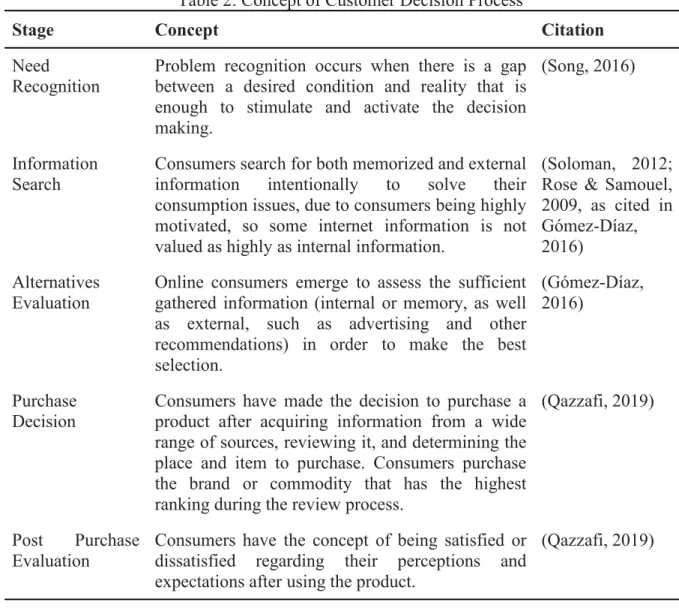
Rise in sales
Instant transactions
Low cost of advertising
- Consumer Trust
- System Quality of E-commerce Platforms
- Perceived Usefulness
- Perceived Ease of Use
- Attitude Towards Using E-commerce
- Behavioural Intention
- Actual System Use
- Buying Decision
- Original Theoretical Framework
- Hypothesis development
- The relationship between trust and perceived usefulness
- The relationship between system quality of E-commerce platforms and perceived ease of use
- The relationship between perceived usefulness and attitude toward use of the E- commerce platforms
- The relationship between perceived ease of use and attitude toward use of the E- commerce platforms and perceived usefulness
- The relationship between attitude toward use of the E-commerce platforms and behavioural intention to use E-commerce platforms
- The relationship between behavioural intention to use E-commerce platforms and actual E-commerce platforms use
- Difference between age and perceived ease of use and perceived usefulness
- Proposed Theoretical Framework
- Summary
Customers' trust is assumed to have a direct influence on the perceived usefulness of the e-commerce platforms. According to the framework of the research, the variable perceived usefulness depends on attitudes towards the use of e-commerce platforms. Based on our research framework, the variables of perceived ease of use will have a significant influence on the attitude towards using the E-commerce platforms.
In TAM, behavioral intention to use a system is directly determined by an individual's attitude toward using e-commerce platforms and the subjective likelihood that using a particular e-commerce platform or application will increase perceived usefulness (Jackson et al., 1997). According to Figure 2, the framework shows that behavioral intention to use e-commerce platforms will lead to customers' purchase decision. RQ4: Can age groups reduce the difference between perceived usefulness and perceived ease of use of e-commerce platforms.

3.1 Introduction
- Research design
- Measurement
- Demographics
- Variables Test
- Sampling Method
- Sample size
- Respondent
- Data analysis
- Descriptive analysis
- Regression analysis
- ANOVA
- Pilot study
- Reliability of Instrument
- Summary
Cross-sectional survey will be used for this study as this survey involves a one-time linking of the information. By using the e-commerce platforms to obtain a product, I would be able to do my shopping faster. It will be easy for me to become proficient in using the e-commerce platforms to purchase a product.
The three questions of Cheema et al. 2013) were not included as questionnaires for this study due to the lengthy text that will be replaced by Heijden's questionnaire. How many products have you purchased via e-shopping via e-commerce platforms in the last month?
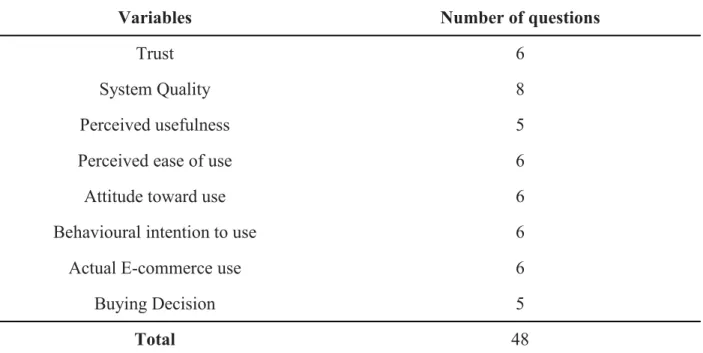
4.1 Introduction
- Descriptive analysis
- Reliability analysis
- The influence of consumer trust and system quality on E-commerce platforms use According to the theoretical framework, the influence of consumer trust and system
- The influence of E-commerce platforms use on the buying decisions of consumers Actual E-commerce use was tested using simple linear regression to determine if
- The difference of perceived usefulness and perceived ease of use by age group
- Theoretical framework with beta value
- Summary
The influence of e-commerce platform system quality on perceived ease of use was tested using simple linear regression. It was found that system quality of e-commerce platforms had a beneficial effect on perceived ease of use (β = .741,p < .001), indicating that hypothesis 2 was supported in this setting. Simple linear regression was used to determine whether perceived usability was positively influenced by perceived ease of use of the e-commerce platforms.
Attitude towards using e-commerce platforms was found to have a positive effect on behavioral intention to use e-commerce platforms (β= 0.836, p< 0.001), indicating that hypothesis 6 is supported in this setting. The effect of behavioral intention to use e-commerce platforms on actual e-commerce use was tested using simple linear regression. A one-way ANOVA was conducted to compare age groups between perceived usefulness and perceived ease of use of e-commerce platforms.

5.1 Introduction
The Influence of Consumer’s Trust and System Quality of E-commerce platforms toward the Buying Decisions
There is a positive relationship between system quality and perceived ease of use of the e-commerce platforms supported by Lee et al. Based on the results in Chapter 4, hypothesis 4 shows that perceived ease of use is an important predictor of attitudes towards usage of e-commerce platforms. There is a positive relationship between perceived ease of use and perceived usability in ecommerce platforms.
Consequently, the perceived usefulness of e-commerce platforms will be influenced by the perceived ease of use, according to the findings of this research. According to the findings, there is a positive relationship between attitude towards using e-commerce platforms and behavioral intention to use the platforms. As a result, behavioral intention to use e-commerce platforms will have an impact on actual use of e-commerce platforms, according to their research findings.
E-commerce platforms use influence the buying decisions of consumers
The differences in perceived usefulness and perceived ease of use by age group Perceived ease of use is a person's belief that employing information technology will
This is because all age groups of adults and educated people are moving away from traditional shopping and towards online shopping (Manoj et al., 2022). Additionally, some of the studies show that there is a difference between age groups, but the age range of the studies is not consistent. For example, Mondego and Gide's (2020) assertion that younger populations that are more tech-savvy are more likely to use digital payment technologies than older populations in society.
Implications
PR practitioners can take advantage of the findings of this study, which can be used to craft more effective messages for their clients' audiences. As public relations practitioners, they may be able to develop public relations messages that are based on this evidence and are beneficial to the organization. At this point, public relations professionals can take advantage of the public's trust in XYZ to develop a public relations message that draws public attention to the new product, such as the benefits of promoting the new product on the market and the general public, and then receiving public feedback on the new product.
Moreover, the present research can help public relations practitioners to accurately target the potential audience. Public relations practitioners can refer to the characteristics of different age groups by knowing their concerns to adjust their preference, such as actual shoe product images with multiple types available on screen versus screen hiding; some may consider the current value of product image or reviews before purchase. For example, the public relations practitioners can use the strategies of partnering with favorite celebrities or influencers, offer discount promotion and brand loyalty programs for customers to attract and retain the younger ages who buy online.
Limitations
Recommendations
In other words, consideration of products offered on online platforms, trust and perception of system usability should be linked to the concerns of age groups to help design the most appropriate business plan and strategy. Given the increasing number of e-commerce platforms in use today, future researchers will need to consider other variables (e.g., playability, habits, and usability) that may influence important components of the TAM in order to limit factors in order to expand future research. Moreover, this kind of research can help more merchants or establishments to promote their e-commerce businesses to raise the overall level of business.
A meta-analysis determined an odds ratio (OR) of 1.44, indicating that a reminder increases the ratio of responders to refusers by 44 percent (Edwards et al., 2007). Reminders can be useful because the effort made by a researcher to remind potential respondents increases the perceived importance of the study (Wensing et al., 1999). Furthermore, according to the ease of processing theory, repeated exposure to a stimulus leaves an imprint on long-term memory, and if one is exposed to a comparable stimulus again, this stimulus will be processed better (Whittlesea et al., 1990). .
Summary
Using the technology adoption model to understand academics' behavioral intent to use learning management systems. International Journal of Advanced Computer Science and Applications (IJACSA), 5(1). Benefits and Challenges of Ecommerce Customers and Businesses: In Indian Perspective.International Journal of Research. Effects of Perceived Risk on Purchase Intent: A Meta-Analysis. Journal of Computer Information Systems.
Towards adaptive websites: conceptual framework en. https://www.researchgate.net/publication/222491894_Towards_adaptive_Web_sites_Conceptual_framework_and_case_study. COVID-19 outbreak in Malaysia: measures taken by the Malaysian government. International Journal of Infectious Diseases.
